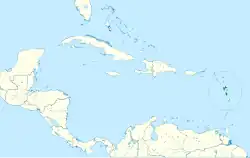Plumbeous warbler
| Plumbeous warbler | |
|---|---|
.jpg)
| |
| Scientific classification | |
| Kingdom: | Animalia |
| Phylum: | Chordata |
| Class: | Aves |
| Order: | Passeriformes |
| Family: | Parulidae |
| Genus: | Setophaga |
| Species: | S. plumbea
|
| Binomial name | |
| Setophaga plumbea (Lawrence, 1877)
| |

| |
| Synonyms | |
| |
The plumbeous warbler (Setophaga plumbea) is a species of passerine bird belonging to the family Parulidae, the New World warblers. This species is found only in Dominica and Guadeloupe in the Lesser Antilles. Its natural habitats are subtropical or tropical dry forest and subtropical or tropical moist lowland forest.
Taxonomy
The plumbeous warbler was first formally described as Dendroica plumbea in 1877 by George Newbold Lawrence with its type locality given as Dominica.[2] This species is now classified within the genus Setophaga which belongs to the family Parulidae, the wood warblers or New World warblers.[3] The plumbeous warbler forms a superspecies with the Elfin woods warbler (S. angelae) of Puerto Rico and the arrowhead warbler (S. pharetra) of Jamiaca.[4]
Etymology
The plumbeous warbler is classified in the genus Setophaga; this name means "moth eater" in Greek. The specific name, plumbea, is Latin and means "lead coloured", a reference to the dull grey, lead-like colour of this bird.[5]
Description
The plumbeous warbler is a small bird with a length of 12 cm (4.7 in). The adults have uniformly grey upperparts with a white supercilium and two white wingbars. The underparts are paler grey with a white belly and centre of the breast. The immatures have greenish-grey upperparts and buffish underparts with less distinct supercilim.[6] The song is made up of between 3 and 12 slow, whistled notes, with the first three being at the same pitch. The call is a dry rattling sound.[7]
Distribution and habitat
The plumbeous warbler is endemic to the Lesser Antilles where it is restricted to Dominica and Guadeloupe, including Marie-Galante and Îles des Saintes.[8] This species is found in humid montane forests as well as in drier scrub and mangroves.[6]
References
- ^ BirdLife International (2016). "Setophaga plumbea". IUCN Red List of Threatened Species. 2016: e.T22721743A94728305. doi:10.2305/IUCN.UK.2016-3.RLTS.T22721743A94728305.en. Retrieved 13 November 2021.
- ^ Lawrence, George N. (1879). "Descriptions of new species of birds from the island of Dominica (Art. IV)". Annals of the New York Academy of Sciences. 1. New York Academy of Sciences: 46--49. doi:10.1111/j.1749-6632.1879.tb00274.x.
- ^ AviList Core Team (2025). "AviList: The Global Avian Checklist, v2025". AviList: The Global Avian Checklist. doi:10.2173/avilist.v2025. Retrieved 13 July 2025.
- ^ Jon Curson; David Quinn; and David Beadle (1994). New World Warblers. Helm Identification Guides. Christopher Helm (Publishers) Ltd. pp. 154–155. ISBN 0713639326.
- ^ Jobling, James A. (2010). The Helm Dictionary of Scientific Bird Names. London, United Kingdom: Christopher Helm. p. 355309. ISBN 978-1-4081-2501-4.
- ^ a b Herbert Raffaele; James Wiley; Orlando Garrido; Allan Keith; Janis Raffaele (2003). Birds of the West Indies. Helm Field Guides. Princeton University Press. pp. 164–165, 170–171. ISBN 978-0-7136-5419-6.
- ^ "Plumbeous Warbler Setophaga plumbea". eBird. Cornell Lab of Ornithology. Retrieved 13 July 2025.
- ^ Vaurie, Charles (1961). "List of and Notes on the Birds of the Iles Des Saintes, French West Indies". The Auk. 78 (1): 57–62.
